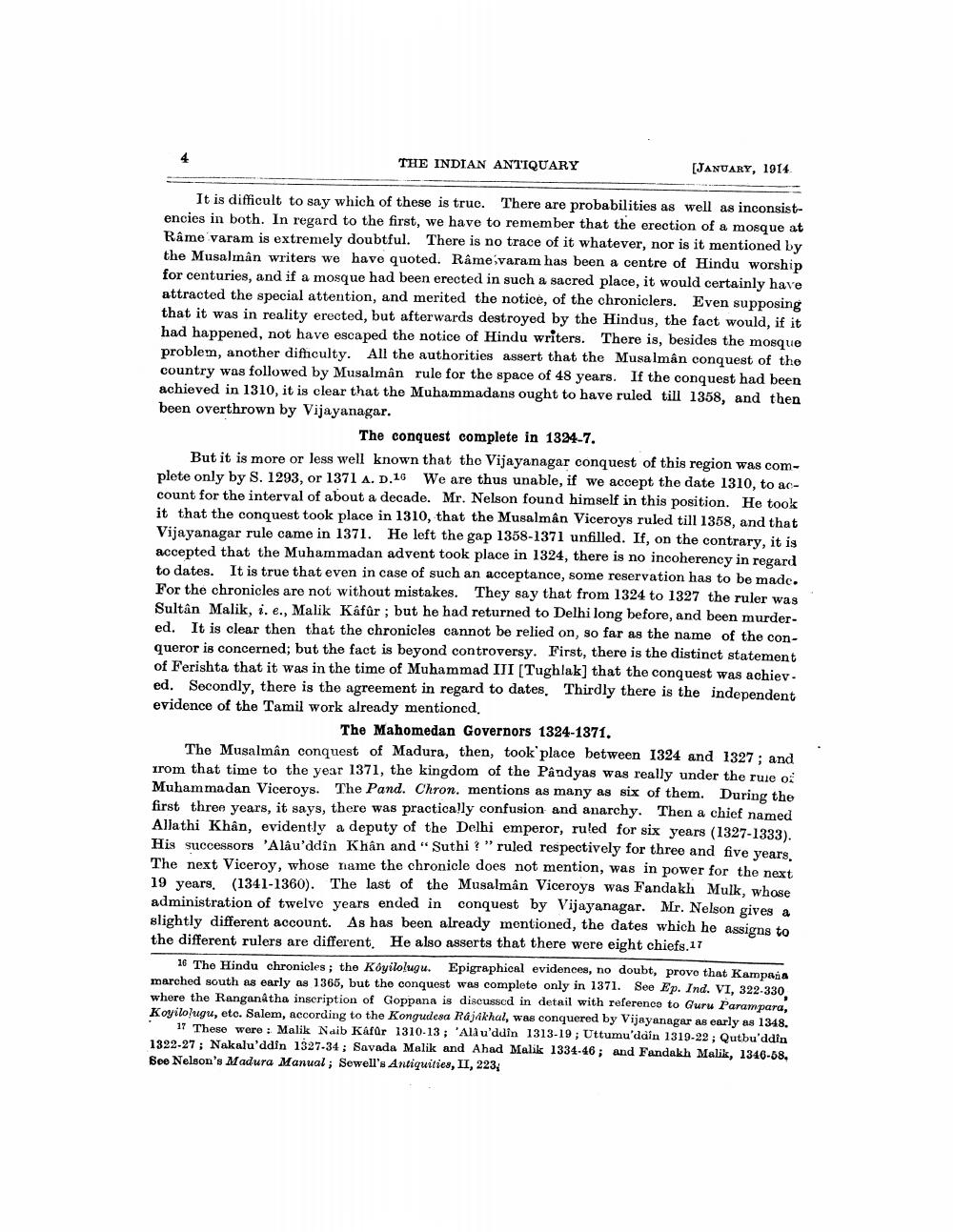Book Title: Indian Antiquary Vol 43 Author(s): Richard Carnac Temple, Devadatta Ramkrishna Bhandarkar Publisher: Swati Publications View full book textPage 8
________________ THE INDIAN ANTIQUARY (JANUARY, 1914 It is difficult to say which of these is true. There are probabilities as well as inconsistencies in both. In regard to the first, we have to remember that the erection of a mosque at Râme varam is extremely doubtful. There is no trace of it whatever, nor is it mentioned by the Musalman writers we have quoted. Râme varam has been a centre of Hindu worship for centuries, and if a mosque had been erected in such a sacred place, it would certainly have attracted the special attention, and merited the notice, of the chroniclers. Even supposing that it was in reality erected, but afterwards destroyed by the Hindus, the fact would, if it had happened, not have escaped the notice of Hindu writers. There is, besides the mosque problem, another difhculty. All the authorities assert that the Musalman conquest of the country was followed by Musalman rule for the space of 48 years. If the conquest had been achieved in 1310, it is clear that the Muhammadans ought to have ruled till 1358, and then been overthrown by Vijayanagar. The conquest complete in 1324-7. But it is more or less well known that the Vijayanagar conquest of this region was complete only by S. 1293, or 1371 A. D.16 We are thus unable, if we accept the date 1310, to account for the interval of about a decade. Mr. Nelson found himself in this position. He took it that the conquest took place in 1310, that the Musalmân Viceroys ruled till 1358, and that Vijayanagar rule came in 1371. He left the gap 1358-1371 unfilled. If, on the contrary, it is accepted that the Muhammadan advent took place in 1324, there is no incoherency in regard to dates. It is true that even in case of such an acceptance, some reservation has to be made. For the chronicles are not without mistakes. They say that from 1324 to 1327 the ruler was Sultan Malik, i.e., Malik Kafûr ; but he had returned to Delhi long before, and been murdered. It is clear then that the chronicles cannot be relied on, so far as the name of the conqueror is concerned; but the fact is beyond controversy. First, there is the distinct statement of Ferishta that it was in the time of Muhammad IJI [Tughlak] that the conquest was achiev. ed. Secondly, there is the agreement in regard to dates. Thirdly there is the independent evidence of the Tamil work already mentioned The Mahomedan Governors 1324-1871. The Musalman conquest of Madura, then, took place between 1324 and 1327; and irom that time to the year 1371, the kingdom of the Pandyas was really under the rule of Muhammadan Viceroys. The Pand. Chron. mentions as many as six of them. During the first three years, it says, there was practically confusion and anarchy. Then a chief named Allathi Khan, evidently a deputy of the Delhi emperor, ruled for six years (1327-1333). His successors 'Alau'ddin Khan and "Suthi ? ”ruled respectively for three and five years. The next Viceroy, whose name the chronicle does not mention, was in power for the next 19 years. (1341-1360). The last of the Musalman Viceroys was Fandakh Mulk, whose administration of twelve years ended in conquest by Vijayanagar. Mr. Nelson gives a slightly different account. As has been already mentioned, the dates which he assigns to the different rulers are different. He also asserts that there were eight chiefs.17 16 The Hindu chronicles; the Köyilolugu. Epigraphical evidences, no doubt, prove that Kampaia marched south as early as 1365, but the conquest was complete only in 1371. See Ep. Ind. VI, 322-330 where the Ranganatha inscription of Goppana is discussed in detail with referenco to Guru Parampara, Koyilolugu, eto. Salem, according to the Kongudesa Rajakhal, was conquered by Vijayanagar as early as 1348. 17 These were : Malik Naib Kafar 1310-13 ; 'Alau'ddin 1313-19; Uttumu'dain 1319-22 ; Qutbuddin 1322-27; Nakalu'ddin 1327-34 ; Savada Malik and Ahad Malik 1334-46; and Fandakh Malik, 1346-68. Boe Nelson's Madura Manual ; Sewell's Antiquities, II, 223,Page Navigation
1 ... 6 7 8 9 10 11 12 13 14 15 16 17 18 19 20 21 22 23 24 25 26 27 28 29 30 31 32 33 34 35 36 37 38 39 40 41 42 43 44 45 46 47 48 49 50 51 52 53 54 55 56 57 58 59 60 61 62 63 64 65 66 67 68 69 70 71 72 73 74 75 76 77 78 79 80 81 82 ... 344
